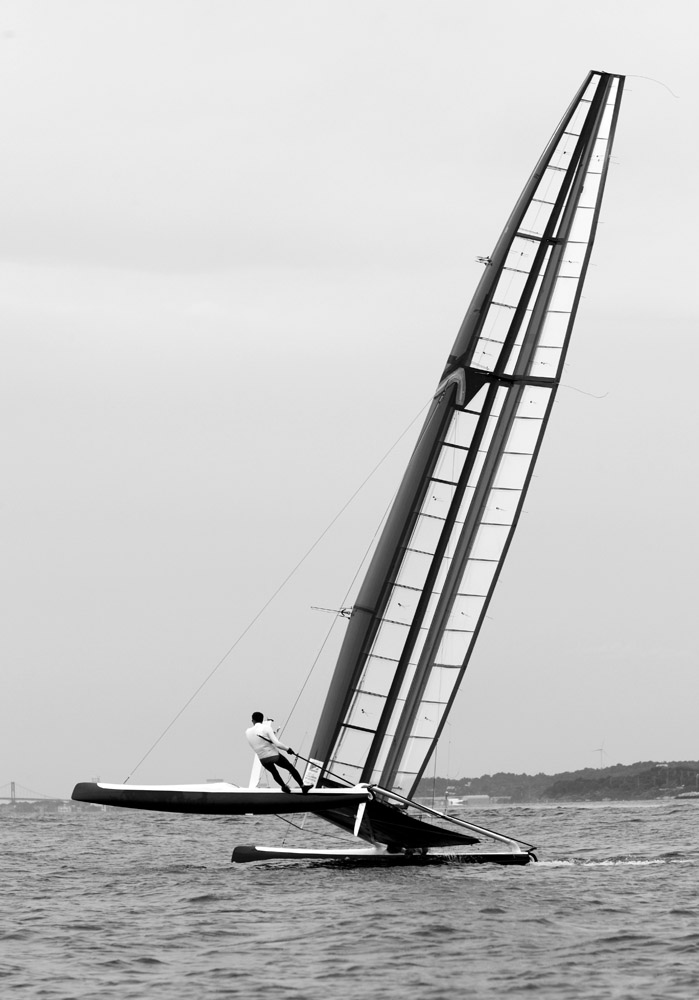
In 2004, I had the privilege of visiting some Airbus aerospace engineers in Bristol, UK to see their latest project: a sail boat named Invictus. They had designed the catamaran with a rigid sail–it looked and acted like an airplane wing–to compete in the international C-Class catamaran championships. It was quite a sight, seeing a sail that looked like it had been lopped off a jet and propped upright on a double-hulled boat.
Invictus didn’t win that competition, and it didn’t win the most recent one in 2007, but the team is going for it again. This week, the championship regatta was scheduled to kick off in Bristol, RI, but due to high winds the race has been postponed. When the winds let up, no doubt the teams from the UK, Canada, France, and the U.S. will hit the water and show what their boats are made of.
If you want to know more about this competition, check out my Gizmodo article here. I also wrote about the boats for The Economist in 2004. The story is here, but it’s behind a paywall, so I’ve pasted it below.
Winging it
The world’s most high-tech regatta, the Little America’s Cup, has just started
Dateline: BRISTOL
A BOAT in an aeroplane hangar is an odd sight. Odder still is that instead of having a floppy fabric sail, this vessel–a catamaran–sports a rigid wing which appears as though it has been chopped from an aeroplane, propped upright, and tethered to the hulls. But Invictus, as the boat is named, is not as out of place as it looks, for it was designed by aerospace engineers and will be sailed by John Downey, a retired Concorde pilot.
A so-called C-class catamaran, Invictus is Britain’s entry in the Little America’s Cup–a sailing competition being held off the coast of Rhode Island from September 16th to 26th. Invictus, and Ronstan, an Australian boat, will be trying to take the cup from the American defender, Cogito.
C-class catamarans are the whippets of the yachting world. The relaxed membership rules of the category (maximum dimensions and sail area are prescribed, but little else is) have made C-class cats an experimental designer’s dream. The result is vessels that can reach 30 knots (56kph) in a 15-knot wind–the sort of wind speed expected off the coast of Rhode Island at this time of year. In the proper America’s Cup, by contrast, competitors would be lucky to reach 10 knots in such conditions.
The chief feature that distinguishes a modern C-class from a normal catamaran is that solid, wing-like sail. Just as an aircraft wing provides lift when air flows past it as the plane flies, so a solid sail provides lift as the wind blows past it–except that the “lift” drives the vessel forwards, because the sail is held upright at an angle to the wind. It is this lift-like force that can carry a boat forward faster than the wind that is propelling it.
Such forward-directed lift is not unique to a solid sail. A fabric sail also works at least partly in this way (the billowed curve induced in the fabric by the wind acts as an aerofoil). But conventionally rigged vessels cannot travel as fast as C-cats because canvas, and its modern replacements, have disadvantages over solid sails.
First, unlike a fabric sail, a rigid sail does not need to waste time finding its shape before lift happens. Second, a fixed sail’s carefully designed shape produces lift at a much smaller angle to the wind than does a fabric sail. That means a C-class vessel can make small, rapid turns–an ideal feature for a race in which the boats zigzag their way up and down a fixed course.
Third, a rigid sail supports itself. That means the tension in the cables that attach it to the hulls is minimal. As a result, the hulls, and the bracing between them, do not need to be as strong (and therefore as heavy) as would otherwise be the case. Indeed, the vessel itself weighs little more than the two people who crew it.
Add flaps, which provide extra lift in gentle winds in the same way that they stop a plane from stalling when it is landing, and put a 15° twist in the sail to account for the fact that the wind at the top of a sail moves faster than the wind at the bottom, and you have the ultimate sailboat. Which of the three competitors is the ultimate ultimate will soon become clear.

2 Responses to Sail Boats with Wings